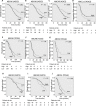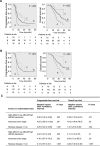ABCA transporter gene expression and poor outcome in epithelial ovarian cancer
- PMID: 24957074
- PMCID: PMC4110473
- DOI: 10.1093/jnci/dju149
ABCA transporter gene expression and poor outcome in epithelial ovarian cancer
Abstract
Background: ATP-binding cassette (ABC) transporters play various roles in cancer biology and drug resistance, but their association with outcomes in serous epithelial ovarian cancer (EOC) is unknown.
Methods: The relationship between clinical outcomes and ABC transporter gene expression in two independent cohorts of high-grade serous EOC tumors was assessed with real-time quantitative polymerase chain reaction, analysis of expression microarray data, and immunohistochemistry. Associations between clinical outcomes and ABCA transporter gene single nucleotide polymorphisms were tested in a genome-wide association study. Impact of short interfering RNA-mediated gene suppression was determined by colony forming and migration assays. Association with survival was assessed with Kaplan-Meier analysis and log-rank tests. All statistical tests were two-sided.
Results: Associations with outcome were observed with ABC transporters of the "A" subfamily, but not with multidrug transporters. High-level expression of ABCA1, ABCA6, ABCA8, and ABCA9 in primary tumors was statistically significantly associated with reduced survival in serous ovarian cancer patients. Low levels of ABCA5 and the C-allele of rs536009 were associated with shorter overall survival (hazard ratio for death = 1.50; 95% confidence interval [CI] =1.26 to 1.79; P = 6.5e-6). The combined expression pattern of ABCA1, ABCA5, and either ABCA8 or ABCA9 was associated with particularly poor outcome (mean overall survival in group with adverse ABCA1, ABCA5 and ABCA9 gene expression = 33.2 months, 95% CI = 26.4 to 40.1; vs 55.3 months in the group with favorable ABCA gene expression, 95% CI = 49.8 to 60.8; P = .001), independently of tumor stage or surgical debulking status. Suppression of cholesterol transporter ABCA1 inhibited ovarian cancer cell growth and migration in vitro, and statin treatment reduced ovarian cancer cell migration.
Conclusions: Expression of ABCA transporters was associated with poor outcome in serous ovarian cancer, implicating lipid trafficking as a potentially important process in EOC.
© The Author 2014. Published by Oxford University Press. All rights reserved.
Figures





References
-
- Levi F, Lucchini F, Negri E, et al. Cancer mortality in Europe, 1995–1999, and an overview of trends since 1960. Int J Cancer. 2004;110(2):155–169 - PubMed
-
- Dean M. The genetics of ATP-binding cassette transporters. Methods Enzymol. 2005;400:409–429 - PubMed
-
- Szakacs G, Annereau JP, Lababidi S, et al. Predicting drug sensitivity and resistance: profiling ABC transporter genes in cancer cells. Cancer Cell. 2004;6(2):129–137 - PubMed
-
- Fletcher JI, Haber M, Henderson MJ, et al. ABC transporters in cancer: more than just drug efflux pumps. Nat Rev Cancer. 2010;10(2):147–156 - PubMed
Publication types
MeSH terms
Substances
Grants and funding
LinkOut - more resources
Full Text Sources
Other Literature Sources
Medical
Miscellaneous

